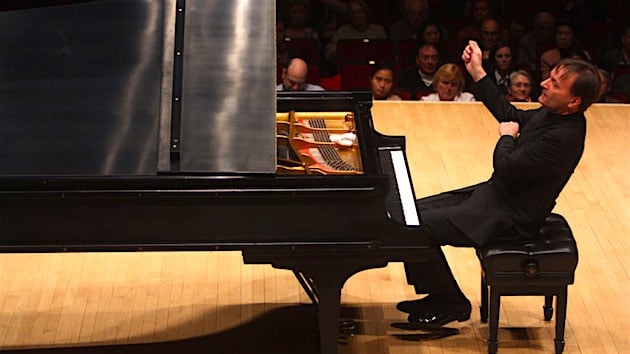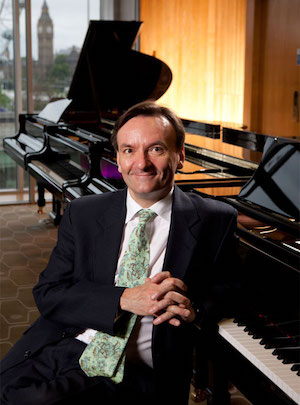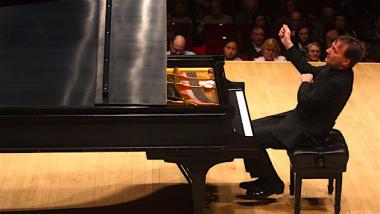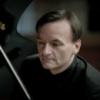
When a cerebral pianist such as Stephen Hough programs a recital, you look for the hidden connections. Hough is a polymath who not only plays and composes, he writes (he just published his first novel, The Final Retreat) and paints as well. His recital at Herbst Theatre on January 18 invited pattern-spotting, consisting of two halves that mirrored or paralleled each other.
Both halves opened with a moonlit piece by Debussy, followed by each of the Images sets, but in reverse: In the first half, Debussy’s early and popular “Clair de Lune” was paired with the later, more tonally ambiguous second book of Images. In the second half, “La terrasse des audiences au clair de lune” (The terrace of moonlit audiences) from the second book of Preludes preceded the earlier and more straightforward first book of Images.
The big works that anchored each half, Schumann’s Fantasy in C Major, Op.17 and Beethoven Sonata in F Minor, Op.57 “Appassionata,” have underlying parallels between them: Schumann’s Fantasy, a ravishing, passionate love-letter to Clara Wieck (later his wife), is loosely in sonata form, and it even quotes from Beethoven’s song cycle, An die ferne Geliebte (To the Distant Beloved) at the end of the first movement, a mark of Schumann’s devotion to his musical hero.
|
Composer |
First Half |
Commonality / Contrast |
Second Half |
|---|---|---|---|
|
Debussy |
Suite Bergamasque: Clair de Lune |
Moonlight / Tonality |
Preludes, Livre II: |
|
Debussy |
Images, Livre II |
Images / Tonality |
Images, Livre I |
|
Schumann, Beethoven |
Fantasy in C Major |
Passion/ Beethoven quote (in Fantasy) / Rhythmic freedom |
Sonata in F Minor, “Appassionata |
Of course, such a beautifully constructed program would be for naught if not well played. Hough did not disappoint. The familiar “Clair de Lune” was interpreted with the most delicate of sighs, yet it evoked a sensation of traveling through the sky. The elation was nearly Scriabinesque. Then Hough dove into “Cloches à travers les feuilles (mélancolie diffuse)” (Bells through the leaves (diffuse melancholy)). Beginning with whole-tones, the piece opens a door to a different world.

Debussy rejected the term “impressionist,” instead preferring to call his music “symbolist” connecting to poets, like Paul Verlaine, whose work inspired many musical settings. When compared with Impressionistic paintings, Debussy’s music is mistakenly interpreted, as eschewing focus and clear outlines. Here, even in the ambiguous tonality of the whole tone scale, Hough consistently maintained clear melodic lines and counterpoints. In the volatile “Poissons d’Or” (Goldfish) inspired by a Japanese lacquer piece, the capricious movement of the brocaded carps jumped out of the agitated water.
The agitated koi pond easily led into the ravishing world of Schumann’s Fantasy. Here, phrases were broad, with deliberate, lyrical lines that sang Schumann’s ardor. In the middle section, the dark melodies contrasted with well-articulated accompaniment that perhaps illustrated anguish. The triumphant second movement rolled on like a gregarious crowd on a train and the meditative third movement had a recitative-like quality. Here, I thought that the rarely performed, original ending, which is similar to that of the first movement might have been more fitting. Unfortunately, noise from a rowdy crowd just outside the hall marred the most intimate moments.
Hough’s heavily perfumed rendition of “La terrasse…” contrasted with the first book of Images. “Reflets dans l’eau” (Reflections in the water) was stirring yet playful. In “Hommage à Rameau,” Hough’s pronounced pauses, added gravity. In “Mouvement,” a perpetual motion of 16th-note triplets, he kept an exact tempo.
That precision was a fitting segue to a stern reading of Beethoven “Appassionata” Sonata. Repeated notes possessed clear definition, and the dotted note rhythm was precisely rendered. Here, the word “passion” meant intensely focused emotion, not the overwhelming flow of ardor in Schumann. Yet, a singularly focused drive carried the incessant 16th notes in the last movement, when the emotions held in stoically until then broke loose
A tender reading of the last variation from Schumann’s posthumous symphonic etudes was a sweet and calming conclusion.



